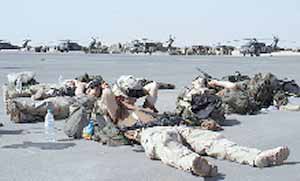The pilots have trained on brown-out landings extensively in the last year and since arriving in the Iraqi theater a month ago. But it is still a high risk - some even consider it the most dangerous part of a mission like the one Friday night. "It's literally the scariest thing I've done in my life," Haws said. The first crash happened just minutes into the mission, which began about 8 p.m. The pilot from the 2nd Battalion over-torqued the helicopter during the take-off, Haws said. The decision was made as a precaution, but the helicopter crashed a short time later, Haws said. The second helicopter crashed as it landed after completing its mission at about 10:30 p.m. "I saw the dust cloud over the entire helicopter," said Spc. Russell Buckhard, 23, of Miami, who was on standby to reload Hellfire missiles onto the aircrafts. "I heard a loud smash with sparks flying," A pilot from the first crash had a possible broken leg, but the others were considered in relatively good shape. "They're already joking about taking parts off the aircrafts," Haws said. "These guys will bounce back. They'll be OK." Haws, however, said losing the aircraft is a loss: One cost $22 million; the second, with a more advanced radar system cost $27 million. "We can't crash two every night," Haws said. A third Apache from the 1st Battalion was grounded after its computer system malfunctioned. A security team was dispatched to recover it. There was no substantial damage from enemy fire to the choppers, but they did take some small arms and anti-aircraft fire, Haws said. Pilots participating in the mission were not told about either crash until after they had safely landed. "It was a little scary until I got out and realized what happened," said Chief Warrant Officer 2 Jeff Lamprecht, 31, of Woodlawn, Tenn., of the second crash, which he saw after taking out three Iraqi tanks with Hellfire missiles during the mission.
|
